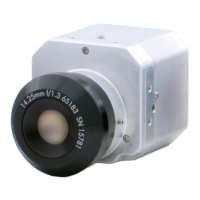43
Thermographic
Measurement Techniques
Thermographic
Measurement Techniques
Introduction
An infrared camera measures and images
the emitted infrared radiation from
an object. The fact that radiation is a
function of object surface temperature
makes it possible for the camera to
calculate and display this temperature.
However, the radiation measured by the
camera does not only depend on the
temperature of the object but is also a
function of the emissivity. Radiation also
originates from the surroundings and is
reected in the object. The radiation from
the object and the reected radiation will
also be inuenced by the absorption of
the atmosphere.
To measure temperature accurately, it
is therefore necessary to compensate
for the eects of a number of dierent
radiation sources. This is done on-
line automatically by the camera. The
following object parameters must,
however, be supplied for the camera:
The reected temperature•
The distance between the object and •
the camera
The relative humidity•
The emissivity of the object•
The most important object parameter to
set correctly is the emissivity which, in
short, is a measure of how much radiation
is emitted from the object, compared to
that from a perfect blackbody.
Normally, object materials and surface
treatments exhibit emissivity ranging
from approximately 0.1 to 0.95. A highly
polished (mirror) surface falls below 0.1,
while an oxidized or painted surface
has much higher emissivity. Oil-based
paint, regardless of color in the visible
spectrum,has an emissivity of over 0.9
in the infrared. Human skin exhibits an
emissivity close to 1.
Non-oxidized metals represent an
extreme case of almost perfect opacity
and high spectral reexivity, which
does not vary greatly with wavelength.
Consequently, the emissivity of metals is
low – only increasing with temperature.
For non-metals, emissivity tends to be
high and decreases with temperature.
Finding the Emissivity of an Object
Using a Thermocouple
Select a reference point and measure
its temperature using a thermocouple.
Alter the emissivity until the temperature
measured by the camera agrees with
the thermocouple reading. This is
the emissivity value of the reference
object. However, the temperature of the
reference object must not be too close to
the ambient temperature for this to work.
Finding the Emissivity of an Object
Using Reference Emissivity
A tape or paint of a known emissivity
should be put onto the object. Measure
the temperature of the tape/paint using
the camera, setting emissivity to the
correct value. Note the temperature.
Alter the emissivity until the area with the
unknown emissivity adjacent to the tape/
paint has the same temperature reading.
The emissivity value can now be read.
The temperature of the reference object
must not be too close to the ambient
temperature for this to work either.
Appendix B

